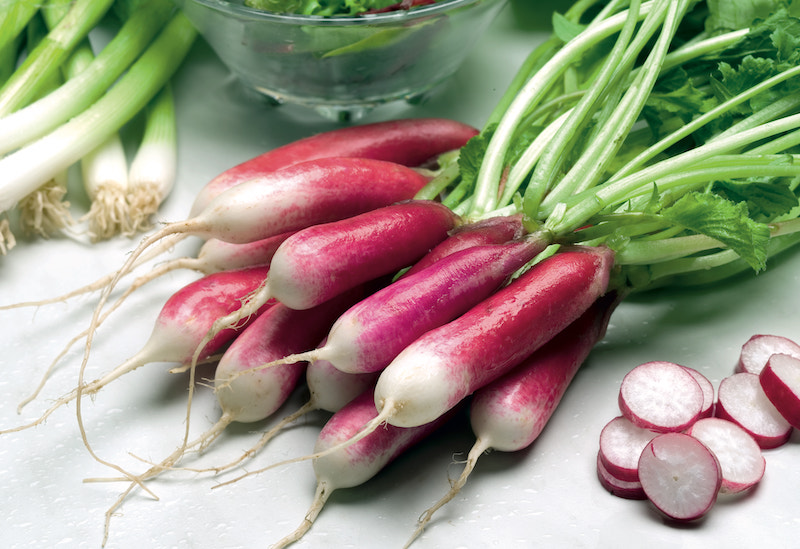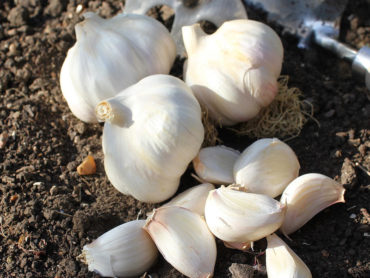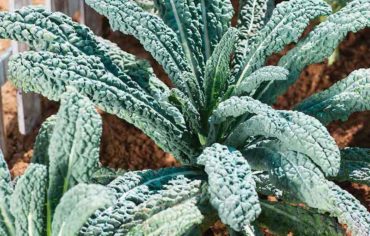Radishes are one of the quickest and easiest crops to grow, and take up very little room. Many gardeners plant them as a catch crop between other vegetables, but they’re also well worth their space in a dedicated salad bed. Popular in summer salads, why not try growing winter varieties to add a peppery bite to soups and stews? Here are some top tips on how to grow radishes from experienced allotmenteer Lee Senior.
Browse our full range of radish seeds for inspiration.
What are the best varieties of radish to grow?
The majority of radishes are grown for harvesting in spring and summer, but the season can be extended to early winter with a little planning. As a young horticultural student in the 1990s, the first variety of radish I ever grew was ‘French Breakfast’. Today, the fact that the ultra-reliable, summer-cropping ‘French Breakfast 3’ (RHS, AGM winner) is still going strong, speaks volumes. The distinctive cylindrical crimson and white roots are packed full of flavour and it’s still my favourite variety for ease of growing!
These days, radishes come in all shapes, sizes and colours. This is typified by the unique heritage variety ‘Black Spanish Round’. This autumn and winter variety has unique, strikingly black skin which contrasts well with the crispy white flesh. It can be sown early in the year during February and March and then again during late August to early October for use in winter salads. It’s best avoided during the summer. This is my go-to choice for extending the cropping season after the summer varieties have finished. It stores very well too.
For summer varieties, I really like Radish ‘Royal Purple’ for its gentle, sweet flavour. It’s a little less peppery than many others, proving that not all radishes taste the same! With vibrant, pale-purple skin, it adds wonderful colour to salads.
‘Scarlet Globe’ also produces a beautifully red, round, summer-cropping radish. The crispy white flesh makes a fine contrast to the strikingly vivid red roots. This AGM winner is also quite sweet tasting when picked early, and very visually attractive.
Finally, for something completely different, why not try the oriental radish mooli? Mooli ‘Neptune’ has long, white, tapered roots which have good resistance to bolting and store longer than salad radishes. The crispy white flesh has a mild flavour that is less peppery.
How and when to sow radish seeds
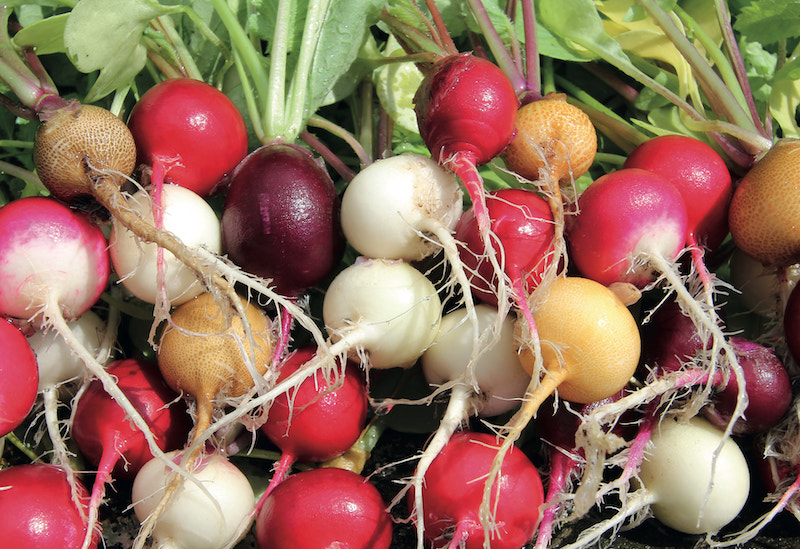
Image: Radish ‘Rainbow Mix’ seeds from Suttons (© T&M)
Radish is a great crop for beginners and also for introducing children to gardening. With the exception of cress, radish seeds are probably the easiest of any to germinate.
Start germinating your radish seeds indoors or under glass from early mid-March onwards. They require a minimum temperature of 10C, but usually germinate within 3-4 days when conditions are favourable. Sow the seeds at a depth of 1cm and lightly cover with compost.
For the best results, I prefer to direct sow radish seeds outdoors during the warmer months. Start sowing from early April as the soil warms up, and continue sowing summer-cropping types until mid-September. Sow the seed in standard drills at a depth of 1cm in soil worked to a fine tilth. Pre-water the drill if conditions are dry.
You can also sow radishes in large pots and containers in the cold greenhouse from late winter.
During good growing conditions, summer radishes can be ready to harvest in just 28 days. Four to five weeks is typical, so some planning is required to avoid a glut. Sowing regularly, every 2-3 weeks, is the best option for continuity of harvest.
Where to plant radishes
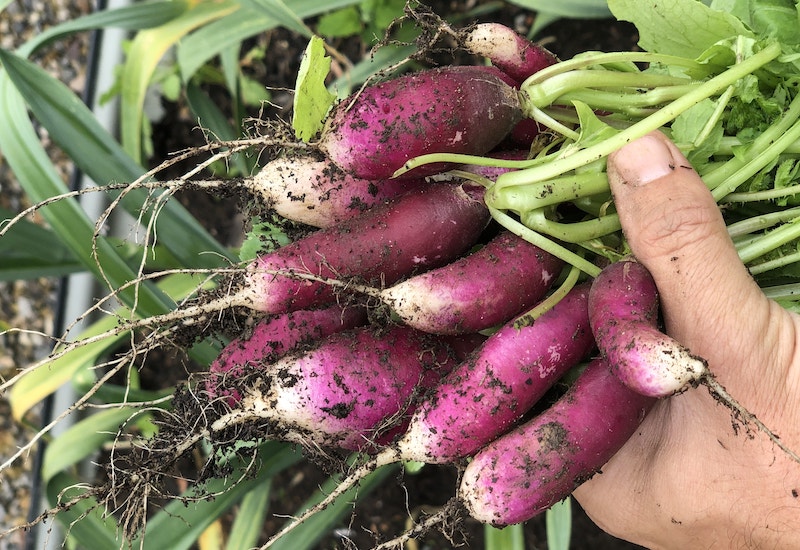
Image: Radish ‘Felicia’ seeds from Suttons (© T&M)
Radishes are easy-going and not very demanding with their requirements. They enjoy full sun or partial shade and plenty of moisture. During the height of summer, it’s a good idea to avoid the hottest parts of the garden as too much heat can encourage the plants to bolt.
Radishes make an excellent catch crop. Simply sow them outdoors directly into the same seed drill as a slow-to-germinate crop such as parsnips. The radishes will germinate quickly and be harvested long before the parsnips really get going. Catch-cropping helps to mark the rows and also makes best use of available space.
Over the years, I’ve found that radishes grow well at a spacing of 3cm per plant in rows around 20 cm (8 inch) apart. They will grow well at similar spacings in good-sized containers too. If they’re too close together, they sometimes fail to produce a worthwhile crop.
The other way to grow radishes is in small pockets or clusters, dotted around here and there. Rather than long, straight rows, try using them to plug any gaps that are not in use.
How to care for radishes
Radishes are members of the brassica family and are generally an easy crop to grow and care for. They prefer cool conditions and like plenty of water during warm dry spells. This also helps to minimise the risk of bolting.
Flea beetle is a common pest, identified by characteristic holes in the leaves. Generally they’re not a serious pest if the plants are otherwise healthy, and I tend to ignore them. Slugs are also a threat, especially during damp weather.
When to harvest radishes

Image: Radish ‘Black Spanish Round’ seeds from Suttons
The majority of radishes have a peppery flavour when harvested. This can vary in intensity according to the type and variety.
My top tip for harvesting is to pick them before they get too large. Experience will show you what the optimum harvest size is for your own personal preference, but small is always beautiful. Larger roots soon become woody, and turn rather unpalatable as a result. If in doubt, it’s best not to leave them just a few days longer!
As the roots age beyond suitable use, their shape subtly changes and the foliage starts to take on an increasingly prickly feel. If plants are left to grow wild, they’re best handled with gloves when you pull them up.
Don’t worry if you miss the harvest window. Leave your plants to mature and watch as they become considerably taller. The flowers are quite attractive, and the resulting seed pods are perfectly edible with an intense peppery flavour.
Summer radishes can be stored in the fridge for a few days after harvesting but are best eaten within five days. Winter varieties will store for several weeks or more, either in the soil or in damp boxes of soil or sand.
We hope we’ve inspired you to try growing your own radishes from seed. Find more of Lee’s practical, hands-on, vegetable growing advice over at his monthly allotment pages. You can also follow Lee on his Instagram page: @lee_senior_gardening.
Lead image: Radish ‘French Breakfast 3’ Seeds from Suttons (© T&M)

